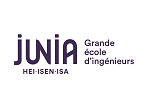Establishment
Language of instruction
English, French
Teaching content
MB-ST
Training officer(s)
X.WALLART
Stakeholder(s)
X.WALLART, P.DIENER, Louis BIADALA
Présentation
Prerequisite
To attend this course, the student should master the basics in Quantum Mechanics and Solid-State Physics learned in CSI3.
Goal
The goal of this course is to provide the student with the basic concepts in semiconductor physics allowing the understanding of the working principles of the opto and microelectronic devices encountered in everyday life: transistors, photodiodes, electroluminescent diodes.
At the end of the course, the student should:
- Master the general equations driving the free carrier concentrations and their evolution versus space and time in semiconductor materials
- Know the different working regimes of a diode and a transistor
- Understand the interaction between light and a semiconductor
- Have a flavor of the future trends in opto and microelectronic devices
At the end of the course, the student should:
- Master the general equations driving the free carrier concentrations and their evolution versus space and time in semiconductor materials
- Know the different working regimes of a diode and a transistor
- Understand the interaction between light and a semiconductor
- Have a flavor of the future trends in opto and microelectronic devices
Presentation
The course is divides in two main parts. The first one is devoted to the fundamental concepts in semiconductor physics and will allow the student:
- Identifying the key parameters in the semiconductor band structure : band gap (direct and indirect), effective mass
- Making the difference between an intrinsic and extrinsic semiconductor with both n and p-type doping
- Calculating the free carrier concentrations et the conductivity of a semiconductor
- Establishing the evolution versus space and time of the free carrier densities
- Describing the optical absorption and the luminescence
The second part of the course will focus on the description of the working principles of semiconductor devices, in such a way that the student will:
- Understand the detailed mechanisms at hand in a p-n junction, a MOS transistor, a photodiode and an electroluminescent diode.
- Know the key material parameters in the device operation
- Detect the device limitations
- Link this knowledge to the use of the devices in microelectronic circuits for everyday life applications
- Identifying the key parameters in the semiconductor band structure : band gap (direct and indirect), effective mass
- Making the difference between an intrinsic and extrinsic semiconductor with both n and p-type doping
- Calculating the free carrier concentrations et the conductivity of a semiconductor
- Establishing the evolution versus space and time of the free carrier densities
- Describing the optical absorption and the luminescence
The second part of the course will focus on the description of the working principles of semiconductor devices, in such a way that the student will:
- Understand the detailed mechanisms at hand in a p-n junction, a MOS transistor, a photodiode and an electroluminescent diode.
- Know the key material parameters in the device operation
- Detect the device limitations
- Link this knowledge to the use of the devices in microelectronic circuits for everyday life applications
Modalités
Forms of instruction
Lectures, exercises and reading of publications and articles
Organization
| Type | Amount of time | Comment | |
|---|---|---|---|
| Face to face | |||
| Lectures - face to face | 14,00 | ||
| Exercises | 14,00 | ||
| Independent study | |||
| Independent study | 52,00 | ||
| Overall student workload | 80,00 | ||
Evaluation
Written test & report






